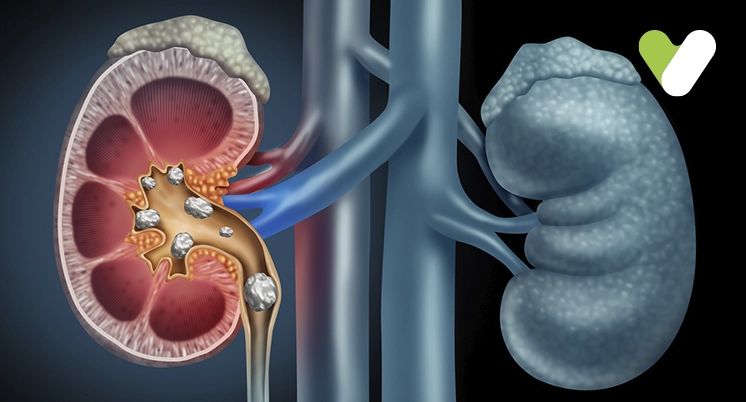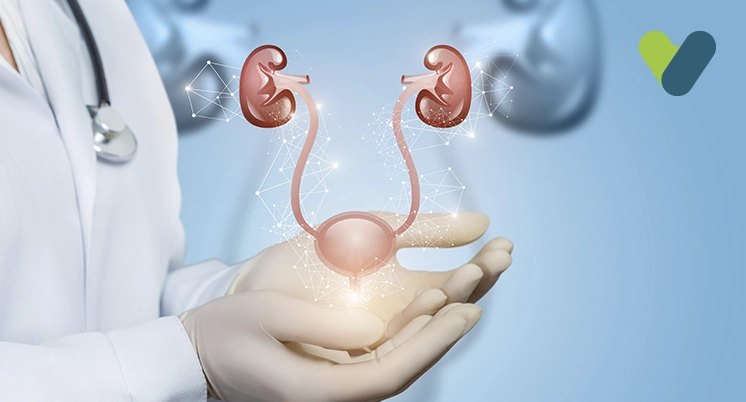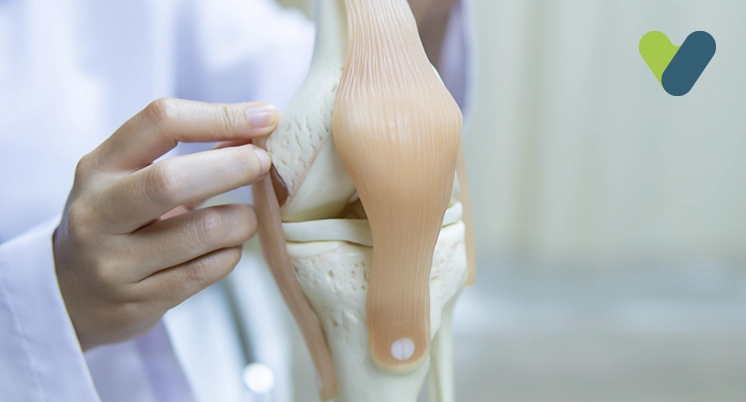Overview
Kidney stones are solid crystals consisting of salts and minerals that develop inside the kidneys. They are sometimes referred to as renal calculi, nephrolithiasis, or urolithiasis. Kidney stones can be caused by a variety of factors, including diet, weight gain, various medical problems, specific supplementation, and drugs. Each section of the urinary tract, from the kidneys to the bladder, can be damaged by kidney stones. When urine is concentrated, minerals can crystallise and bind to each other, frequently leading to kidney stones.
Chronic kidney disorders, end-stage kidney failure, heart disorders, diabetes, and high blood pressure are all linked to a high risk of kidney stones. Kidney stone surgery is necessary to remove all kidney stones to prevent the aforementioned serious medical conditions. A kidney stone may be surgically removed from the body either entirely or in fragments during a kidney stone operation, or it may be destroyed to allow it to flow through the body and pass through urine.
Kidney stone surgery could be required if kidney stones are trapped inside the urinary tract, are linked to inflammation, or cause discomfort. The kidney stone might be surgically removed by a urologist or divided into small parts. The kidney stone can be divided by the urologist by using a shock wave lithotripsy. The minute fragments of the kidney stone are then eliminated through the urine tract.
The kidney stone surgery cost depends on the type of kidney stone surgery carried out, and the cost is different for different locations. The average kidney stone surgery cost in India is 30,000–1,00,000 INR depending on the type of procedure performed.
Why is surgery for kidney stones performed?
- The surgical removal of a kidney stone is performed to ease the symptoms and/or treat a problem that is linked to the stone's existence. Kidney stone surgery is performed for a variety of reasons, such as
- To remove kidney stones bigger than 10 millimetres
- To eliminate distal ureteral stones smaller than 10 mm, which remain present even after 4 to 6 weeks of monitoring and treatment
- In pregnant women with kidney or urinary stones, to remove stones that haven't disappeared after the evaluation period
- To eliminate kidney stones that show symptoms when the patient has no other cause for their suffering
- To treat urinary tract disorders, which are related to kidney stones and reoccur often
- To treat continuous kidney blockage caused by kidney stones
In addition to the warning signs listed above, the following circumstances may necessitate urgent removal of a kidney stone:
- If an individual has both the infection of the urinary system and an obstructive kidney stone
- In the event of acute kidney damage as well as a blockage in the urine output from both kidneys
- If an individual only has one functional kidney and gets acute renal damage from an obstructive kidney stone
Types of kidney stone surgery
The four main surgical procedures used to remove kidney stones are:Ureteroscopy
- A narrow, flexible telescope is used by the doctor during this surgery to locate and extract stones from the kidneys and ureters. In addition, there are no skin incisions done during this surgical process.
- As a part of this procedure, a tiny telescope is put into the bladder and urethra, and then, this telescope is pushed into the ureter to the location of the stone. At this point, the procedure is carried out. The procedure usually lasts for 1 to 3 hours, and it is usually done while the patient is unconscious.
- Tiny stones can usually be extracted from the ureter without too much difficulty. The stone needs to be broken, which is often performed with a laser; however, if the kidney stone is big or the ureter's diameter is small, laser treatment might be necessary as well. These particles are extracted after the kidney stone is divided into tiny fragments.
Shock Wave Lithotripsy (SWL)
- The most popular kidney stone surgery for individuals is shock wave lithotripsy. For people with small or medium-sized kidney stones, it works well. The best aspect of this procedure is that it is non-invasive, which means that no incisions are made on the skin and that high-intensity shock waves are utilised to shatter kidney stones.
- During this surgical treatment, shock waves are directed to the kidney stone, causing it to break up into smaller fragments. Therefore, the stones smash into small fragments. Another procedure can be used if significant pieces remain even after the procedure. The ideal size for SWL is a stone with a diameter of <2 centimetres. If the stones are large, the procedure may not be sufficiently effective.
Open surgery
- Open surgery is an uncommon procedure used to remove kidney stones. Large stones or those that can't be extracted or broken with conventional therapies have to be treated surgically.
Surgery is beneficial in situations when:
- The ureter is blocked by stones
- An individual is in extreme discomfort
- Urine flow is being obstructed by the kidney stone
By inserting a stent into the ureter to aid in urine drainage, an aperture is created through which the kidney stone can be extracted. In general, it can take 4 to 6 weeks for someone to recover fully from open surgery, and they will need to stay in the hospital for a long duration of time.
Percutaneous Nephrolithotomy
- This method involves removing the kidney stone in patients who have big or irregularly shaped stones, infections, and stones that haven't been sufficiently broken up by SWL, or individuals who haven't received therapy from the above-mentioned methods of treatment. The target audience for this surgical operation is patients who have stones larger than 2 centimetres.
- A tiny cut in the back is performed to access the kidney. A nephroscope (a tiny fibreoptic lens) and other tiny pieces of equipment are passed into the opening after the surgeon has reached the kidney. Nephrolithotomy refers to the removal of the kidney stone through the tube. Nephrolithotripsy refers to the breaking up of the stone and complete removal of the stone. The stone is broken up by using high-frequency sound vibrations, and the particles are then collected with a suction device. These are a few of the surgical alternatives that are available to those who have kidney stones. The appropriate option will be chosen by a doctor depending on the severity of the kidney stone. However, before making a decision and weighing the benefits and drawbacks of the treatment option that one is selecting for oneself, it is crucial to speak with a doctor and properly understand the condition and the issue.
How to prepare for kidney stone surgery?
- The doctor will tell you how to get prepared if your surgery for kidney stones is scheduled.
- It's crucial to stick to these guidelines. But keep in mind that urgently required surgeries won't be cancelled as a result of failure to prepare for surgery for kidney stones. The measures that must be taken for kidney stone operation include:
- Choose loose-fitting clothing that is simple to take off because you will need to put on a hospital gown when you go for a kidney stone operation.
- On the day before your procedure, do not eat or drink after midnight.
- Ask your medical professional for advice on a timetable for stopping some medicines that could result in bleeding.
- Inform your doctor in advance about all the medicines you are currently consuming, especially prescribed, as well as non-prescribed, nutritional supplements, and herbal medicines.
What recovery measures should be taken after the surgery?
Depending on the procedure used, time require for recovering after a kidney stone operation differs. But if you have shock wave lithotripsy (SWL) or a ureteroscopy, you can most likely resume your usual tasks after 2 to 3 days. The other operations require a lengthier recovery period. With percutaneous nephrolithotomy, anticipate a recovery period of 1 to 2 weeks, and for open surgery, that of 4 to 6 weeks. Your doctor (often a nephrologist, who is a kidney expert) will request an MRI scan 2 to 3 months following your kidney stone operation. To verify that you are clear of all stones and all stone pieces have been cleared, an MRI scan is done. In addition, based on the chemical makeup of the kidney stone, your doctor will develop a plan for you to help prevent future kidney stone episodes.
There are three essential methods for avoiding stones:
- Continuously clear out the urinary tract, and consume approximately eight cups of water. If you're not comfortable drinking so much water in a day, start out slowly and increase the portions.
- Your diet may need to be adjusted depending on the type of kidney stone you had. You could be told, for instance, to eat less protein and avoid meals and drinks with sugars. You can also be advised to consume more veggies and fruits.
- According to the kind of kidney stone you had, your doctor may advise taking specific drugs.


